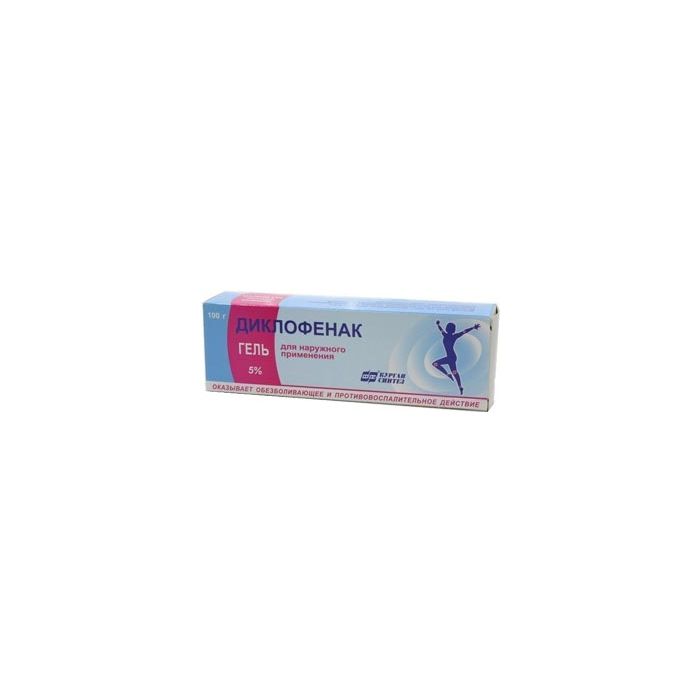Diclofenac gel d / nar. approx. 5% 100g
Dosage:
5% x 100g
5% x 30g
5% x 50g
Category
Bruises, sprains
Scope of the drug
Musculoskeletal system
Release form
Gel
Manufacturer country
Russia
Package quantity, pcs
one
Quantity per package 100 g Dosage form gel for external use Manufacturer Synthesis AKOMP, Russia Composition Active ingredient: sodium diclofenac 50 mg. Pharmacological action Diclofenac is a non-steroidal anti-inflammatory drug (NSAID). It has anti-inflammatory, analgesic and antipyretic effects. Inhibits the COX enzyme in the cascade of arachidonic acid metabolism and disrupts the biosynthesis of prostaglandins. When applied externally, it has anti-inflammatory and analgesic effects. Reduces and relieves pain at the site of application of the ointment (including joint pain at rest and during movement), reduces morning stiffness and swelling of the joints. Promotes increased range of motion. Indications for inflammatory and degenerative diseases of the joints (osteochondrosis, osteoarthritis, periarthropathy) rheumatism of soft tissues traumatic bruises sprains of ligaments, muscles and tendons inflammatory edema of soft tissues arthralgia and myalgia caused by heavy physical exertion. Contraindications pathological changes in the blood picture of unclear genesis peptic ulcer of the stomach and duodenum destructive-inflammatory bowel diseases in the acute phase pregnancy lactation period (you should stop breastfeeding) children and adolescents up to 12 years old (intramuscular injection, supp.) children under 6 years of age (tablets, ointment) hypersensitivity to acetylsalicylic acid or other NSAIDs (including the aspirin triad") hypersensitivity to diclofenac and other components of the drug inflammation of the rectum - proctitis (suppositories) Side effects At the site of application, skin rash, burning, redness are possible.With prolonged external use of the drug, it is possible to develop systemic side effects from the digestive system, central nervous system, respiratory system, as well as allergic reactions. Interaction With the simultaneous use of the drug Diclofenac with digoxin, phenytoin or lithium preparations, it is possible to increase the plasma concentrations of these drugs with diuretics and antihypertensive drugs - it is possible to reduce the effect of these drugs with potassium-sparing diuretics - hyperkalemia may develop with acetisalicylic acid - a decrease in the concentration of diclofenac in the blood plasma and an increased risk of side effects. Diclofenac may increase the toxic effect of cyclosporine on the kidneys. Diclofenc may cause hypo- or hyperglycemia,therefore, when used simultaneously with hypoglycemic agents, control of the concentration of glucose in the blood is required. When using methotrexate within 24 hours before or after taking Diclofenac, an increase in the concentration of methotrexate and an increase in its toxic effect is possible. With simultaneous use with anticoagulants, regular monitoring of blood coagulation indicators is necessary. How to take, course of administration and dosage In a dose of 2-4 g, apply a thin layer on the skin over the focus of inflammation and rub lightly, the frequency of use is 2-3 times a day. The maximum daily dose of the ointment should not exceed 8 g. The course of treatment is no more than 14 days. The need for a longer use of the drug is determined by the doctor. Storage conditions In a dry place at a temperature of 8 to 15 В° C. Freezing is not allowed. Expiry date See packaging.Active ingredient Diclofenac Conditions of dispensing from pharmacies Without prescription
Name ENG
DICLOFENAC
Clinical and pharmacological group
NSAIDs for external use
ATX code
Diclofenac
Dosage
5% x 100g
Structure
Active ingredient: diclofenac sodium 50 mg.
Indications
Post-traumatic inflammation of soft tissues and joints due to sprains, overstrains and bruises
rheumatic diseases of soft tissues (including tendovaginitis, bursitis, damage to periarticular tissues)
pain and swelling associated with diseases of the muscles and joints (including rheumatoid arthritis, osteoarthritis, radiculitis, lumbago, sciatica)
muscle pains of rheumatic and non-rheumatic origin (for 5% gel).
INN / Active ingredient
diclofenac diethylamine
Storage conditions and periods
At a temperature of 15-25 degrees (do not freeze).
Expiration date: 3 years
Contraindications
Hypersensitivity to diclofenac or other components of the drug, acetylsalicylic acid or other NSAIDs.
Complete or incomplete combination of bronchial asthma, recurrent polyposis of the nose and paranasal sinuses, angioedema or urticaria and intolerance to acetylsalicylic acid or other NSAIDs (including a history).
Pregnancy (III trimester), breastfeeding period, childhood (up to 12 years).
Violation of the integrity of the skin at the intended site of application.
Specifications
Category
Bruises, sprains
Scope of the drug
Musculoskeletal system
Release form
Gel
Manufacturer country
Russia
Package quantity, pcs
one
Minimum age from
6 years
Way of introduction
On the skin
Vacation conditions
Without recipe
Brand name
Synthesis
The amount of the dosage form in the primary package
100 g
Primary packaging type
Tuba
Type of consumer packaging
Pack of cardboard
Pharmaco-therapeutic group
NSAIDs
Anatomical and therapeutic characteristics
M02AA15 Diclofenac
Dosage form
Gel for external use
The target audience
Children
Dosage (volume) of the substance in the preparation
diclofenac sodium 50 mg
Expiration date in days
1095
Package weight, g
150
Mode of application
:
At a dose of 2-4 g, apply a thin layer on the skin over the focus of inflammation and rub it lightly, the frequency of use is 2-3 times a day.
Drug action
:
Pain reliever
,
Anti-inflammatory
,
Analgesic
,
Antipyretic
Information on technical characteristics, delivery set, country of manufacture "

